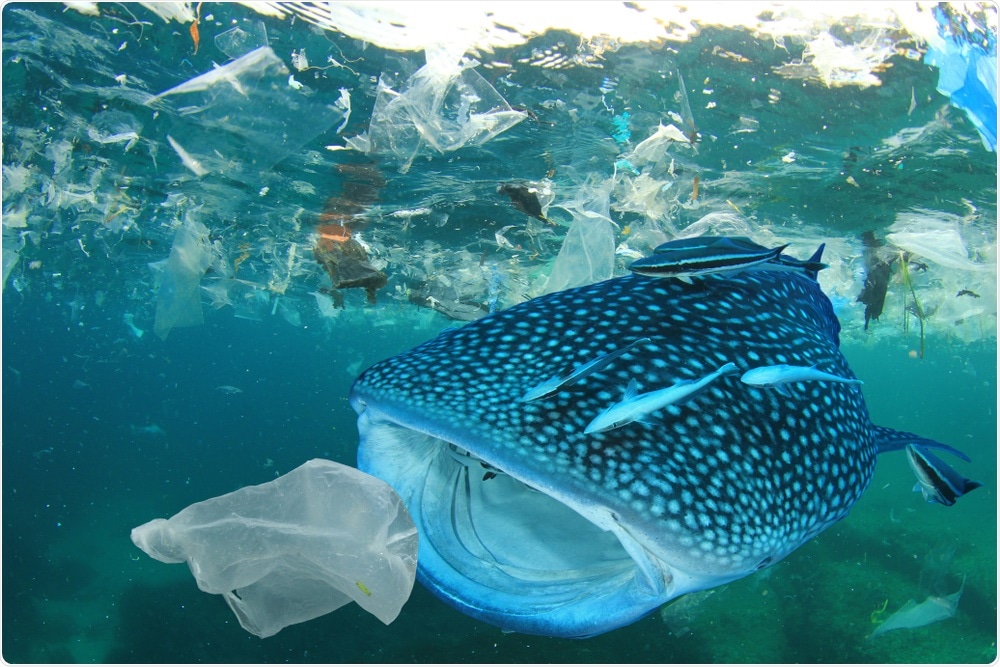Why is plastic pollution a global problem? Why has plastic pollution increased over the years?
Since its creation, plastic production has been increasing exponentially worldwide. Plastics are cheap, durable, and long-lasting materials, which translates into negative implications when they turn from a useful product into an environmental pollutant.
Given the massive amount of plastic we use as humans daily, plastic contamination within our bodies is not a surprise and deserves our attention. This contamination is not going away; on the contrary, it is growing continuously. It thus behooves us to find out where these polluting polymers travel and how they impact our health and wellbeing.
Plastic pollution is not ‘just’ an environmental issue. It is personal. Everyone is being exposed, we and others have shown that essentially everyone who lives in the developed world has detectable levels of not just one but multiple plastics in their bodies.

Image Credit: Rich Carey/Shutterstock.com
Plastics can break down over time, but tiny fragments can still be ingested. How does this occur?
Larger plastics are capable of weathering into smaller pieces via many processes that include UV rays from the sun or the salinity of ocean water, for example. Some plastics are created to be small such as microbeads.
Research has shown that lower-tiered organisms can ingest these small plastics, allowing them to move up the food chain to reach top-tiered organisms such as human beings.
Why have there been few studies that have looked at whether these plastic fragments are entering human bodies?
Everyone is being exposed but detecting contamination with confidence is difficult. We and others have shown that essentially everyone who lives in the developed world has detectable levels of not just one but multiple plastic monomers or building blocks in their bodies.
We are now moving on and trying to better understand whether, similarly, nanoplastics and microplastics are detectable in people. We now have demonstrated that if we spike these plastic materials into mammal tissue, we can successfully retrieve, detect, and count them. That is an important step forward but more work needs to be done.
.jpg)
Image Credit: Alexander Raths/Shutterstock.com
What potential health implications could micro and nanoplastics have on human health based on previous animal and wildlife models?
At this point, we have found in human tissue only the monomers of plastic and we now have demonstrated that plastics spiked into mammal organ tissues can be recovered successfully using our method. The search for nano- and microplastics in human tissues is still ongoing and results are still pending.
When a foreign object gets lodged in our body, it can trigger tissue inflammation which may then escalate into more severe health effects, including cancer, information that was gleaned from animal experiments by other researchers.
Plastics have been demonstrated to cause adverse effects in the environment and animals including mammals. Several pathways for human exposure to plastics have been identified, including the consumption of contaminated seafood.
In collaboration with Plastic Oceans International and the Banner Sun Health Research Institute (BSHRI) Brain and Body Donation Program, we are now applying our new method to tissue samples from human lungs, kidneys, and livers. If micro- and nanoplastics are being sequestered in our bodies, our novel method will help in demonstrating their presence.
You are one of the first groups of researchers to examine micro- and nanoplastics in human organs and tissues. Can you describe how you carried out your research?
Again, at this point, we have found in human tissue-specific only monomers of plastics. The search for nano- and microplastics in human tissues is still ongoing and results are still pending. We believe that our research hits on several very new contributions to this field.
First, our method to extract nanoplastics from animal and subsequent human organs and tissues is showing to be effective and will be a novel tool and platform for other researchers to use to further understand the ability of nanoplastics to become sequestered in our tissues and organs.
Secondly, we created a novel, online conversion tool that will aid in the standardization of micro- and nanoplastic reporting units, as well as their morphologies. Inconsistencies in the ways that micro- and nanoplastics are reported hinder comparisons and the advancement of knowledge, which this conversion tool aims to rectify. It will also serve as an interactive database for other researchers to utilize.
Since human tissues are precious and hard to come by, we first started developing this method by using more readily available animal tissues. We spiked known amount into mammalian tissue, digested using a strong acid, dyed it using a dyeing protocol developed in the lab, and analyzed it in a flow cytometer. We will soon be applying this methot to actual human tissue samples housed in our lab.
What did you discover?
Apart from detecting monomers (building blocks) of plastics in human liver and fat tissue, we also demonstrated that could microplastics (5-10-micron diameter), when spiked into mammalian tissue, can be recovered and counted with an extraction efficiency of 50-60%.

Image Credit: Magic mine/Shutterstock.com
You are sharing the computer program that you designed in your research with other researchers. How will the sharing of this information help to build up a database of exposure, and understand the health effects of these plastic particles faster?
We welcome lab scientists, citizen scientists, student researchers, and environmentalists, who find microplastics in the environment or biota, to report their findings in a normalized manner (as mass) to harmonize reporting and make measurements comparable from one study to another.
Do you believe that people should be concerned about the accumulation of these plastic particles in our organs and tissues?
Given the massive amount of plastic we use as humans daily, plastic contamination within our bodies is not a huge surprise and it is something that we need to watch out for and manage better. This contamination is not going away; on the contrary, it is growing continuously. It thus behooves us to find out where these polluting polymers travel and how they impact our health and wellbeing.
How much more research and data are needed before we can accurately determine the effects of these micro- and nanoplastics on human health?
We do understand that the first-generation plastics we manufacture and use today, over half a century after their introduction, are imperfect materials. We also know that we use too much of them and that they accumulate in the environment and some of their building blocks even in people. That is enough information to take action.
However, we also still need to learn more about which plastics get not only into our gastrointestinal system but actually into our bloodstream and tissues, where they accumulate and what the effects are. We hope that the methods we report here will aid in increasing our understanding.
Before we announce any detections, we need to convince ourselves and others that the methods we use are reliable and suitable for recovering polymeric plastic pollution from tissues and organs. That is what we have demonstrated here.
What are the next steps in your research?
We look forward to analyzing housed human tissue and organ samples and to better define who gets exposed, how, and what the consequences are, whether these exposures are from plastic monomers, plasticizers, other coatings or micro- and nanoplastics. Along with these human tissue samples come complex life histories giving us precious insight into potential exposure pathways for plastics to have reached these individuals.
Where can readers find more information?
The article below is a good starting point for a detailed analysis of human tissues:
Assessment of Persistent, Bioaccumulative and Toxic Organic Environmental Pollutants in Liver and Adipose Tissue of Alzheimer’s Disease Patients and Age-matched Controls
DOI: 10.2174/1567205016666191010114744
Furthermore, here is our latest paper: https://dx.doi.org/10.1021/acs.est.0c03121
About Varun Kelkar
Varun is a 3rd year Ph.D. student studying environmental engineering at The Biodesign center for environmental health engineering.
Varun has active in the fields of microplastic pollution research and in wastewater epidemiology, where he is studying harmful contaminants.
About Dr. Charles Rolsky
Dr. Rolsky is a postdoctoral student in Biodesign’s Center for Environmental Health Engineering and is also the Director of Science North America for Plastic Oceans International.

About Professor Rolf Halden
Rolf is a Professor at Arizona State University and Founding Director of the Biodesign Center for Environmental Health Engineering, the nonprofit OneWaterOneHealth, and the ASU startup company, AquaVitas LLC. Rolf has authored over 230 research papers, patents, monographs, and the 2020 popular science book, Environment.
Rolf is an expert in wastewater-based epidemiology for tracking harmful chemicals and infectious disease agents like SARS-CoV-2, the causative agent of the COVID-19 pandemic.
Rolf serves on the Expert Team of the U.S. American Chemical Society and has been invited repeatedly to brief the Environmental Protection Agency, the Food and Drug Administration, the National Academies, the Centers for Disease Control and Prevention, and members of U.S. Congress on environmental health and sustainability challenges.